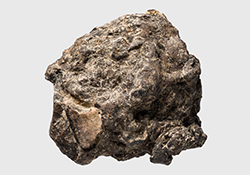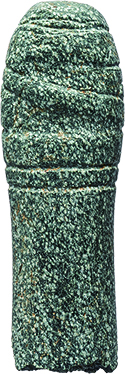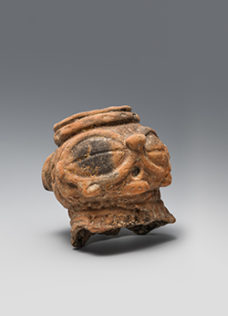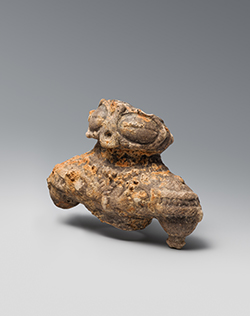Agano City, Niigata Prefecture
Initial portion, Final Jōmon (approximately 3,100–3,000 years ago)
 Embedded pillar building Four main pillars plus two external ridge-end pillars formed a hexagonal type of plan. The span between the ridge-end pillars is 6 m.
Embedded pillar building Four main pillars plus two external ridge-end pillars formed a hexagonal type of plan. The span between the ridge-end pillars is 6 m.
 Map of the site and petroleum source locations Beginning with the Niitsu oil field, a number of petroleum-producing locations concentrate within a radius of 5–10 km from the site. Adapted from Hakkutsu sareta Nihon rettō 2020 [Excavations in the Japanese Archipelago, 2020] (Bunkachō [Agency for Cultural Affairs], ed., Kyodo News, 2020).
Map of the site and petroleum source locations Beginning with the Niitsu oil field, a number of petroleum-producing locations concentrate within a radius of 5–10 km from the site. Adapted from Hakkutsu sareta Nihon rettō 2020 [Excavations in the Japanese Archipelago, 2020] (Bunkachō [Agency for Cultural Affairs], ed., Kyodo News, 2020).
Buried pot This was a pot interred within a pit dug to a depth of about 30 cm. These features concentrate at the settlement’s center, and 46 were detected. Deep bowls predominate, and some were seen with large stones set on the upper surface of the pot.
 |
 |
Asphalt lump (right) and palette (left) Lumps of asphalt totaling 460 g were recovered from the site. The palette was used when painting asphalt on objects.
 |
 |
 |
 |
Artifacts indicating exchange with peoples toward the Pacific Ocean Similar items are found in great numbers in the Tōhoku region. The stone rod uses chlorite (spotted) schist produced in the Kantō region.
Slit-goggle clay figurines Left: Cranial portion. Largest item for Niigata Prefecture. Asphalt adheres to fractured portions of the neck, from which repeated attempts at repair can be seen. Height: 8.6 cm.
Right: Upper body portion. The design has been carefully drawn in fine detail. Height: 9 cm.
A lowland Jōmon settlement linked to the Tōhoku region by the Agano River
A lowland location on the former channel of the Agano River
With Mt. Gozu at its back to the east, and the magnificent Agano River flowing to its west, a rich pastoral lowland spreads over the city of Agano lying in between. The Ishifunato site was a settlement spreading over this lowland from the start and over the initial portion of the Final Jōmon period, situated on the east bank of the former channel of the Agano River, which changed its course with each flooding.
Ascertained during the construction in 1966–67 of a drainage facility, large amounts of pottery and stone tools were recovered in an excavation carried out as an emergency measure. At the time, there were very few examples of excavations within Niigata Prefecture of sites from the initial portion of the Final Jōmon, and the recovered pottery was recognized as important data indicating the diffusion of Kamegaoka culture that was widely distributed over the Tōhoku region.
A full-scale excavation was conducted in the 2012–14 fiscal years, and it was learned that the settlement spread over the top of a slight elevation of about 80-m width extending from southeast to northwest. Comprised of pit structures, embedded-pillar buildings, pits, and buried pots, there were middens on the northern and southern slopes of the elevated ground where pottery and so forth had been discarded, and on the northern side of the settlement were features consisting of stone clusters. From the recovery of clay figurines and stone rods along with scorched earth and large amounts of carbonized nuts and burnt salmon bone, it is imagined that festivals were frequently conducted.
Artifacts showing the actual utilization of asphalt
Numerous artifacts were recovered showing strong influence from the Tōhoku region, such as Ōbora B and BC style pottery, slit-goggle clay figurines and animal-shaped clay objects, and stone tablets. Also, the material used for stone rods included not only stone varieties of Tōhoku, but materials from the northern portion of the Kantō region as well.
In addition, 64 lumps of asphalt were recovered. A highly sticky type of petroleum, asphalt was used for mending pottery and affixing stone points to arrow shafts. More than 1,300 pieces of pottery and stone tools with adhesions of asphalt were recovered, materials highly suggestive of how asphalt was actually utilized in the Jōmon period.
The Ishifunato site settlement is extremely important for considerations of the livelihood and spiritual culture of people of the Jōmon period who lived in lowland areas. Also, among the recovered artifacts there are many items that bring to mind strong ties with peoples living in regions of Tōhoku and Kantō toward the Pacific Ocean, bringing into view a vivid image of exchange and trade via the Agano River of the Final Jōmon period. (Furusawa Yasushi)




